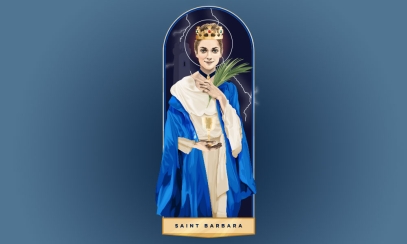
The St. Nick You Never Knew
A Jolly Man in a Red Suit or a Fourth Century Bishop?
Did you know that at one time, the real St. Nicholas was even more popular than Santa Claus is today?
Nicholas was born in the Lycian port city of Patara to wealthy parents. He was orphaned as a child and raised by an uncle who was a priest. The young Nicholas followed in his uncle’s footsteps, but because he did not think it was right for a priest to have so much money, he distributed his inheritance through many acts of charity.
Most people are probably familiar with the story of the poor father with the three daughters. Unable to provide dowries for them, he planned to send them into the street as prostitutes. Nicholas, in the secrecy of night, threw a bag of gold through the man’s window, enough to provide a dowry for the eldest daughter. He did the same for the second girl. But when he went to the house for a third time, the windows were locked. So, Nicholas climbed to the roof and dropped the bag of gold down the chimney where it fell into a stocking drying on the hearth. And that, they say, is how the tradition of Christmas stocking began, although in many countries, St. Nicholas puts goodies in shoes rather than stockings. For this reason, St. Nicholas is the patron of children and of maidens. In art, the three sacks of gold became three gold balls – the symbol of pawnbrokers – who also claim St. Nicholas as their patron.
As a young man, Nicholas traveled to Palestine to visit the holy places where Jesus had lived. On his return voyage by sea, a storm threatened to sink the ship he was on. He came on deck to pray with the sailors and the storm was calmed. The saint is also said to have rescued many other sailors from shipwrecks off the coast of Lycia, making him the patron of sailors and other travelers.
Nicholas became bishop of Myra, in present day Turkey, just about the same time the Roman Emperor Diocletian began his persecution of Christians in 303. Bishop Nicholas spent nearly 10 years in prison for refusing to renounce Christ. He was freed when Constantine became emperor and made Christianity the official Roman religion. He returned home to his people in Myra, participated in the Council of Nicea in 325, and died – already declared a saint – around the year 350.
St. Nicholas was immediately popular in Eastern churches. In 1087, the people of Bari, a coastal town in southeastern Italy, raided Myra and took the remains of St. Nicholas to their city, where they are today in the Basilica of St. Nicholas. Many miracles were reported by people who visited the church in Bari. Churches all over Europe were soon named after the saint – more than 2,000 in all.
In the Middle Ages, celebrations for the feast of St. Nicholas rivaled the feast of Easter – the most important holiday in medieval times. In many places, a boy was crowned “bishop for the day” and parties were held. Several St. Nicholas plays were written and performed. One recounted the tale of St. Nicholas restoring to life three students who had been murdered by an evil innkeeper, cut up and stuffed in a barrel for pickling. This story made him the patron of students, and many college towns, including Oxford, held feasts for students on St. Nicholas Day.
St. Nicholas is the patron saint of Russia, Greece, Bari, Sicily, Amsterdam, and Lorraine, France. He is the patron of children, students, maidens, pawnbrokers, merchants, sailors, travelers, judges, bakers, and paupers. His feast is celebrated on Dec. 6. And whether he makes his appearance as a bishop on a white horse or a jolly old man in red, St. Nicholas is probably one of the most universally known symbols of the Christmas season throughout the world.



